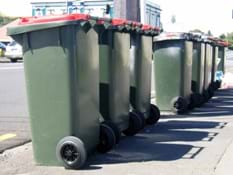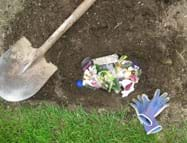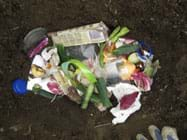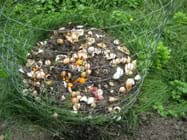Quick Look
Grade Level: 5 (3-5)
Time Required: 2 hours
(two 60-minute sessions, three months apart)
Expendable Cost/Group: US $3.00 (Cost is for the entire class.)
Group Size: 28
Activity Dependency: None
Subject Areas: Biology, Life Science
NGSS Performance Expectations:

| 5-LS2-1 |

Summary
Students bury various pieces of trash in a plotted area of land outside. After two to three months, they uncover the trash to investigate what types of materials biodegrade in soil.Engineering Connection
Waste management engineers use the process of biodegredation to minimize the amount of space that landfills take up. Civil and agricultural engineers take advantage of the biodegradation process in designing waste and water treatment facilities, and making soil improvements to improve crop production.
Learning Objectives
After this activity, students should be able to:
- Explain what the term "biodegrade" means, and generally describe how the process works with respect to the various items of buried trash.
- List what objects do and do not biodegrade (roughly) by explaining the difference between organic and inorganic materials.
- Explain how engineers apply what they know to facilitate waste management.
Educational Standards
Each TeachEngineering lesson or activity is correlated to one or more K-12 science,
technology, engineering or math (STEM) educational standards.
All 100,000+ K-12 STEM standards covered in TeachEngineering are collected, maintained and packaged by the Achievement Standards Network (ASN),
a project of D2L (www.achievementstandards.org).
In the ASN, standards are hierarchically structured: first by source; e.g., by state; within source by type; e.g., science or mathematics;
within type by subtype, then by grade, etc.
Each TeachEngineering lesson or activity is correlated to one or more K-12 science, technology, engineering or math (STEM) educational standards.
All 100,000+ K-12 STEM standards covered in TeachEngineering are collected, maintained and packaged by the Achievement Standards Network (ASN), a project of D2L (www.achievementstandards.org).
In the ASN, standards are hierarchically structured: first by source; e.g., by state; within source by type; e.g., science or mathematics; within type by subtype, then by grade, etc.
NGSS: Next Generation Science Standards - Science
| NGSS Performance Expectation | ||
|---|---|---|
|
5-LS2-1. Develop a model to describe the movement of matter among plants, animals, decomposers, and the environment. (Grade 5) Do you agree with this alignment? |
||
| Click to view other curriculum aligned to this Performance Expectation | ||
| This activity focuses on the following Three Dimensional Learning aspects of NGSS: | ||
| Science & Engineering Practices | Disciplinary Core Ideas | Crosscutting Concepts |
| Develop a model to describe phenomena. Alignment agreement: Science explanations describe the mechanisms for natural events.Alignment agreement: | The food of almost any kind of animal can be traced back to plants. Organisms are related in food webs in which some animals eat plants for food and other animals eat the animals that eat plants. Some organisms, such as fungi and bacteria, break down dead organisms (both plants or plants parts and animals) and therefore operate as "decomposers." Decomposition eventually restores (recycles) some materials back to the soil. Organisms can survive only in environments in which their particular needs are met. A healthy ecosystem is one in which multiple species of different types are each able to meet their needs in a relatively stable web of life. Newly introduced species can damage the balance of an ecosystem. Alignment agreement: Matter cycles between the air and soil and among plants, animals, and microbes as these organisms live and die. Organisms obtain gases, and water, from the environment, and release waste matter (gas, liquid, or solid) back into the environment.Alignment agreement: | A system can be described in terms of its components and their interactions. Alignment agreement: |
Common Core State Standards - Math
-
Multiply and divide within 100.
(Grade
3)
More Details
Do you agree with this alignment?
International Technology and Engineering Educators Association - Technology
-
Most agricultural waste can be recycled.
(Grades
3 -
5)
More Details
Do you agree with this alignment?
-
Explain why responsible use of technology requires sustainable management of resources.
(Grades
3 -
5)
More Details
Do you agree with this alignment?
State Standards
North Carolina - Math
-
Multiply and divide within 100.
(Grade
3)
More Details
Do you agree with this alignment?
North Carolina - Science
-
Understand the interactions of matter and energy and the changes that occur.
(Grade
5)
More Details
Do you agree with this alignment?
Materials List
For the entire class:
- 1 patch of ground (earthy, with soil) that can be used to dig holes in, roughly 1.5 m x 1.5 m (5 ft x 5 ft)
- (optional) string, approximately 12 m (40 ft), for marking off ground segments
- 2 small shovels or trowels, to dig up the soil
- assorted trash and pieces of food (have students save their lunch trash)
- 2 large sheets of poster paper
- disposable gloves, pair for each student
Introduction/Motivation

Now that we have talked about what biodegradation is and everyone has collected some trash from lunch, let's go outside. Bring with you what you saved from lunch.
In this patch of land, we will bury individual pieces of trash in a grid pattern. That way, when we dig it up in three months, we can learn what happened to each type of material. Let's use multiplication to figure out how many spots on the grid are available to bury the individual items.
Now, I want everyone to get together to decide which pieces we will bury. Remember, we want to put as many different materials under the soil, so we can determine which materials biodegrade and which ones do not. Try to avoid burying the same type of garbage twice.
Procedure
Before the Activity
- Identify a small area of earthy ground that is located away from foot traffic and obtain permission to be able to dig up and use the area for the next three months.
- Using a sturdy shovel, dig in the soil to turn it over and mix in any grass or plants). Attempt to create a square of churned-up soil approximately 6 inches deep. Use the string to create a grid over the soil with 1 ft x 1 ft squares, by cutting 8 lengths of 5-ft-long string, laying 4 horizontally and equally spaced, and laying 4 vertically in the same manner.
With the Students

- Instruct students to each save a piece of trash or two from his/her lunch, including sandwich crusts, apple cores, etc. Essentially, tell them they to save whatever is leftover once they have eaten everything they wanted.
- After lunch and in the classroom, give students gloves and have them sort their various pieces of trash into one long row of items, putting like items together. For example, put paper wrappers, foil wrappers, Styrofoam, cardboard each in their own piles.
- On a poster board, draw a table with three columns and these row headers: type of garbage, prediction, result. Record the type of each trash pile its own row. Ask students as a group to predict, for each trash type, whether or not they think that material type will biodegrade over the next three months. Record their predictions.
- Lead the class outside to the prepared soil area. Have students bring pieces of trash they would like to bury. Bring as many different types of trash as possible. As each student buries his or her piece of trash, ask one student draw a grid diagram on another poster board and record where each item is buried in the plot.
- Two to three months later, or longer if the experiment is performed during the winter months, bring the poster boards, shovel and gloves and go outside with the class and dig up the plot. As each plot is dug up, try to identify what is uncovered. Have the students use descriptive words to explain what the piece of trash now looks like, how it changed, and record the results for each piece of trash.
- Conclude with a class discussion, asking students the Investigating Questions.
Vocabulary/Definitions
biodegrade: To decay and become absorbed by the environment.
compost: Remnants of organic materials, usually used in gardening.
decompose: Similar to spoiling, the breaking down of larger molecules into smaller molecules.
inorganic matter: Matter not having the structure or organization characteristic of living bodies.
landfill: A site for the disposal of waste materials by burial.
organic matter: Matter that has come from a recently living organism, is capable of decay, or the product of decay.
Assessment
Quiz: Ask students some questions to gauge their comprehension of the subject matter. Have students individually write their answers on paper to be handed in for grading.
- Write out the definition of the term "biodegradable."
- Describe a dump.
- Describe a compost pile.
- Describe what happens to your household garbage after it is "thrown away."
- List the types of materials that are biodegradable and those that are not.
- (Show students a number of new items of trash.) Identify each item as either biodegradable or not biodegradable.
Investigating Questions
- Which types of garbage decomposed? Why do you think they were able to decompose?
- Which types of garbage did not decompose? Why do you think they were not able to decompose?
- Which types of trash were not recognizable? What happened over the last several months that made those pieces of trash change?
- In what ways might the use of biodegradable materials be helpful to the environment?
Safety Issues
- Handling garbage is unsanitary so make sure that the children wear gloves and wash their hands after they move their trash from the cafeteria to the mock landfill.
- Remind students to be careful when handling the small shovels. If they do not know already, instruct them in the correct way to dig up small amounts of soil at a time.
Troubleshooting Tips
It helps to dig up the soil in the grid area before the children dig their own holes. Locating the test plot in a garden area may make moving the soil easier.
Bury as many different types of trash (different materials) as possible, including a lot of organic items that will readily decompose.
Doing this experiment in the warmer months helps the organic objects decay much faster, and reduces the three-month waiting period a good deal.
Activity Extensions

Create a class compost pile, beginning with the dug-up trash remnants that were found to be biodegradable. This reinforces the concepts covered and provides another hands-on experience.
Subscribe
Get the inside scoop on all things TeachEngineering such as new site features, curriculum updates, video releases, and more by signing up for our newsletter!More Curriculum Like This

Students investigate what types of materials biodegrade in the soil, and learn what happens to their trash after they throw it away. They learn about the concepts behind landfills and compost piles. In an associated activity, students create their own miniature landfills—a hands-on way to learn the ...

Students expand their understanding of solid waste management to include the idea of 3RC: reduce, reuse, recycle and compost. They look at the effects of packaging decisions (reducing) and learn about engineering advancements in packaging materials and solid waste management.

In this lesson, students learn about the three methods of waste disposal in use by modern communities. They also investigate how engineers design sanitary landfills to prevent leachate from polluting the underlining groundwater.

In this lesson, students explore solid waste and its effects on the environment. They collect classroom trash for analysis and build model landfills in order to understand the process and impact of solid waste management.
References
Bagchi, Amalendu. Design of landfills and integrated solid waste management, University of Wisconsin Press. 2004.
57 Ways - 31. Create a Compost Pile. 1995. University of Illinois Extension. Accessed 4/27/07. http://www.thisland.uiuc.edu/57ways/57ways_31.html
Compost. Modified April 23, 2007. Wikipedia. Accessed 4/27/07. http://en.wikipedia.org/wiki/Compost
Organic Material. Modified April 16, 2007. Wikipedia. Accessed 4/27/07. http://en.wikipedia.org/wiki/Organic_material
Biodegradable. Modified April 23, 2007. Wikipedia. Accessed 4/27/07. http://en.wikipedia.org/wiki/Biodegradable
Copyright
© 2013 by Regents of the University of Colorado; original © 2007 Duke UniversityContributors
Roarke HorstmeyerSupporting Program
Engineering K-PhD Program, Pratt School of Engineering, Duke UniversityAcknowledgements
This content was developed by the MUSIC (Math Understanding through Science Integrated with Curriculum) Program in the Pratt School of Engineering at Duke University under National Science Foundation GK-12 grant no. DGE 0338262. However, these contents do not necessarily represent the policies of the NSF, and you should not assume endorsement by the federal government.
Last modified: January 24, 2020









User Comments & Tips